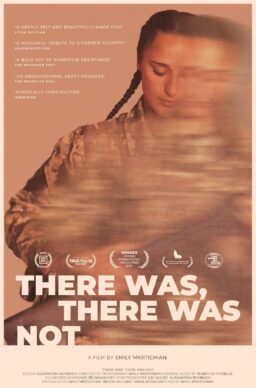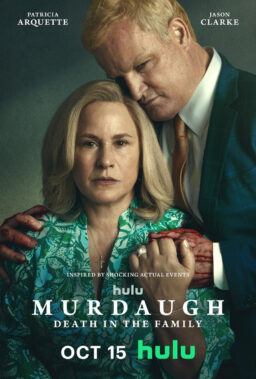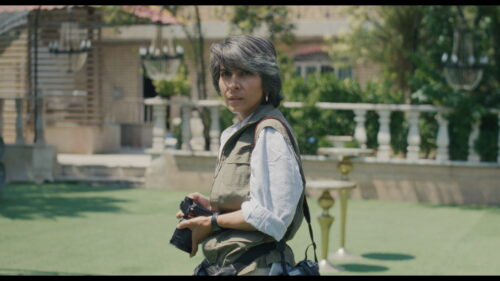“Noah” is a bizarre movie.
It’s a modern blockbuster, chock full of the visual and aural and narrative tics we expect from modern blockbusters: flash-cut nightmares and hallucinations, prophecies and old wise men, predictions of apocalypse and a savior’s rise, computer-generated monsters with galumphing feet and deep voices, brawny men punching and stabbing each other, and crowd scenes and floods and circling aerial views of enormous structures being built, scored to tom-toms and men chanting and women wailing.
But wait: this is not the latest Marvel Comics epic. Nor is it a standard-issue messianic sci-fi film along the lines of “Star Wars” or “The Matrix.” “Noah” is more of a surrealist nightmare disaster picture fused to a parable of human greed and compassion, all based on the bestselling book of all time, the Bible, mainly the Book of Genesis.
More specifically, “Noah” is writer-director Darren Aronofksy’s interpretation of the story of Noah and the flood. He’s made a few changes.
Okay, more than a few. Way more. This is the Book of Genesis after a page one rewrite.
Among other things, Aronofsky has stirred in ideas from earlier film versions of Noah’s story, plus bits from other religions and mythologies, including the Kabbalah, pre-Christian paganism and, it would appear, J.R.R. Tolkien and “The Neverending Story.” And he’s worked in what comic books or long-form TV watchers would term “callbacks” to earlier parts of the Old Testament, including the slaying of Abel by his brother Cain, the death of Noah’s father Lamech, and Adam and Eve’s ejection from the Garden of Eden. The film’s most visually inventive sequence is an ellipsis in the main narrative: a self-contained, time lapse retelling of the birth of the universe—essentially a Big Bang story that could be dropped right into either version of the great science show “Cosmos.” And of course, the international cast speaks with English accents, or tries to, English accents being Hollywood’s way of conveying “foreignness” or “antiquity” without making ticket buyers read subtitles. All the actors have elegantly sculpted eyebrows and gorgeous hair, particularly Russell Crowe‘s Noah, who in one scene sports a teased-up ‘do that makes him look like a beefy version of Christopher Walken in “The King of New York.”
Noah is still the anchor of this partly-waterborne epic. But in this version he is more of an action hero. When the flood waters rise, he changes again, becoming an antihero, and a menace to his own family; their ranks include Noah’s wife wife Naameh (Jennifer Connelly), his sons Shem (Douglas Booth), Ham (Logan Lerman) and Japheth (Leo McHugh Carroll) and Shem’s wife-to-be Ila (Emma Watson). The latter was adopted by Noah as an infant. Much is made of the inferiority complex Ila suffers because of her infertility. She has a supernatural scar on her stomach and cannot bear children. Or so we’re told.
Ila’s infertility proves important later, when she ends up in the belly of a 300x50x30 cubit ark alongside the birds, mammals, reptiles, amphibians and insects under her adoptive daddy’s protection. Before the flood, God spoke to Noah, not in a voice but through a series of mysterious dreams that connect the events of Genesis 6-9 with earlier sections. It goes like this: Adam and Eve were banished from the Garden after Eve fell prey to the serpent’s charms and ate the forbidden fruit (from a tree that looks very much like the Tree of Life in Aronofsky’s “The Fountain“). The descendants of Cain and Abel waged war against each other. The descendants of Cain allied themselves with the The Watchers, a race of fallen angels or seraphim who were encrusted by hardened magma created when they fell from Heaven to earth like shooting stars and smashed craters in the ground; these creatures now lumber across the landscape like Transformers, or like the Ents as visualized in Peter Jackson’s “Rings” movies, grumbling and roaring and making pronouncements in the heavily-filtered voices of Nick Nolte and Frank Langella (who were probably told they had gravel voices at various points during their lives, but never imagined they’d be put to use in quite this way). The Watchers are big and scary, and at first they seem as though they’ll be obstacles to Noah’s mission, but they soon have a change of heart and end up helping Noah and his family build the Ark to beat the flood. But it’s not all hearts and flowers after that, because Noah’s gotten it into his head that only the animals should survive—that after the flood he will have to kill his wife and children and himself, to prevent sinful humanity from angering The Creator again.
And it’s here that things take a turn toward modern-day allegory. As Time’s Richard Corliss points out in an excellent long analysis of “Noah,” the last “adaptation with anything like Aronofsky’s sociopolitical seriousness was the 1928 silent film Noah’s Ark, which compares the flood (‘A deluge of water drowning a world of lust’) to World War I (‘A deluge of blood drowning a world of hate!’).”
Aronofsky’s film seems to have the same aims but different concerns. “Noah” ties God’s wrath to the indiscriminate despoiling of the land and the slaughter of earth’s animal population by greedy and hungry humans. (Noah and his family are vegetarians and view the consumption of meat as a sin against God, referred to here only as “the Creator.”) The deluge, vividly described by Noah as “the waters of the earth meeting the waters of the sky,” is depicted as kind of a nautical version of a panini press that sandwiches the earth’s creatures between slices of roaring water and crushes the life out of them. In this Biblical epic, water doesn’t just rain down and creep up toward the Ark, it gurgles up from the soil, the cracked earth filling up like blood welling in wounds. Sometimes it erupts with geyser-like force. An aerial view of the flood spreading across the land evokes cancer spreading. A spectacular pull-back from the endangered planet shows the atmosphere dotted with dozens of hurricane cloud-whorls.
Aronofsky has also added an action film subplot bulked up with obsessive antihero craziness and daddy issues. He’s inserted the chieftain of Cain’s descendants, Tubal-Cain, described in Genesis as “the forger of all instruments of bronze and iron,” into the story. The character is a warrior-despot enemy of Noah’s and (intriguingly) a dark mirror of Noah’s gravest flaws and worst impulses. As inhabited by Ray Winstone, who plays this sort of raging bull character better than anybody, Tubal-Cain is a creature of pure appetite, and super-macho. The dude put the patriarch in “patriarchal.” He’s all privilege, all entitlement; he thinks everyone and everything (including life itself) exists for his sake. He thinks Noah’s concern about the rape of nature is just a bunch of girly-man whining, stopping just short of calling him a hippie or a tree-hugger. He is determined to take over the Ark and fill it with his own tribe, or barring that, to get on board himself, to survive the flood he once dismissed as false prophecy.
Get on board he does, and once Tubal-Cain and Noah are trapped within the same space: Tubal-Cain peeling off the dissatisfied members of the clan and working them, the way the serpent worked Eve; Noah losing his grip on sanity and goodness and turning into a mad sea captain. Suddenly it’s a haunted-house psychodrama, with two bad daddies terrorizing women and children in the bowels of a waterborne Hotel Overlook. As Noah becomes more unhinged, he starts to physically resemble Tubal-Cain. By the time the two men trade blows, Noah isn’t just fighting a murderous stowaway, he’s fighting to suppress he own worst impulses.
This is, as you’ve gathered, an immense, weird, ungainly, often laughably overwrought and silly movie, an amalgamation of elements from various literary and cinematic forebears. Some elements fuse beautifully and others seem to repel each other; still others float onscreen in isolation, like bits of wreckage carried along by floodwater. Aronofsky will rightly be criticized for adding a lot of images and notions that make Noah’s story less, rather than more, special—elements you can’t escape at movie theaters because every modern fantasy and sci-fi film and disaster picture seems to have been imagined by the same screenwriting hive-mind, and envisioned by the same boring CGI software. The Watchers with their clomping feet; the early scenes of tribal combat and “You killed my daddy!” emoting; the scenes between Noah and his aged grandfather Methuselah (Anthony Hopkins) that turn the latter into sort of a Biblical equivalent of Yoda or E.T.; Noah and Tubal-Cain whaling on each other in the belly of the ark: you’ve seen it all in recent years, over and over, in all manner of Hollywood blockbuster.
And yet there’s still a ferocious originality to “Noah.” Despite its assemblage of borrowed and stolen and re-imagined pieces, you have never seen anything quite like it. It’s a disaster movie with environmentalist overtones and CGI rock-beasts and animals and apocalyptic events, and musings on the primal roles of the father and the mother, and the parents’ desire to control their uncontrollable children, and all of this is periodically interrupted by flash-cuts of the serpent in the garden, and a glowing hand picking forbidden fruit, and Cain bashing Abel’s brains in silhouette. Aronofsky’s “cubits” are actual cubes: the finished Ark is comprised of blocks, and when it bobs on brackish waves it looks like a giant wooden Lego brick. Sometimes Aronofsky puts everything else on hold so that Ray Winstone can deliver a monologue about why man is not just entitled but obligated to kill and eat animals and use the land however he sees fit, or so that Russell Crowe can tell the story of the Big Bang by candlelight or sing an infant to sleep in a quieter version of his Inspector Javert voice from “Les Miserables.”
Throughout the movie’s running time, a word kept flashing in my head: “fervor.” Aronofsky is a fervent filmmaker. He always has been, from his debut feature “Pi” onward. Many aspects of “Noah” feel like an organic continuation of themes and elements that have obsessed him for the past fifteen years: husbands and wives and fathers and mothers and sons and daughters protecting, dominating, excluding and terrorizing each other; the alluring power of obsession, be it for drugs (“Requiem for a Dream“), romantic nostalgia and denial of death’s finality (“The Fountain”) or artistic ambition (“Black Swan“); the intrusion of supernatural or mythical or uncanny events into “normal” life; the notion that sanity and rationality are fragile mental states that can be easily shattered by trauma or disaster.
If I had to compare “Noah” to any previous Biblical movies, I’d go with Mel Gibson’s “The Passion of the Christ” and Martin Scorsese’s “The Last Temptation of Christ,” not because the stories are similar (obviously they aren’t; Old Testament vs. New) but because, even when you’re confused or disgusted or bored, you still feel the director’s mad passion radiating from the screen. Aronofsky has made a major, perhaps catastrophic tactical error, in that we can always feel his obsessive certainty but we can’t quite translate it into our own terms, as we should be able to do with any fable or cautionary tale that’s meant to illuminate or instruct. What’s onscreen often feels more like a visual transcript of one man’s fantasy or nightmare, with all the baffling or nonsensical juxtapositions of this and that and the other thing left intact, exactly as Aronofsky’s sleeping mind first encountered them.
The net effect reminded me of one of my favorite passages from the New Testament, 1 Corinthians 14.4: “Anyone who speaks in a tongue edifies themselves, but the one who prophesies edifies the congregation.” Aronofsky is speaking in tongues here, edifying himself but not the congregation. But it’s not every day that you get to see a major American filmmaker speak in tongues, babbling to a theater full of strangers about the astonishing dream he had, a dream that he’s sure is important, even though he can’t explain precisely why. You don’t see movies like this everyday. You don’t see movies like this ever. That’s not nothing.




















